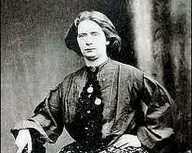Maria Barbella
| Maria Barbella | |
|---|---|
 Portrait of Maria Barbella | |
| Born |
October 24, 1868 Ferrandina, Italy |
| Died | After 1902 |
| Nationality | Italian |
| Other names | Maria Barberi[1] |
| Known for | First woman sentenced to die in the electric chair |
Maria Barbella (born October 24, 1868[2]) was the first woman sentenced to die in the electric chair. She was convicted of killing her lover in 1895; however, the ruling was overturned in 1896 and she was freed.
Life
Maria Barbella was born in Ferrandina, Basilicata, Italy. Her family immigrated to Mulberry Bend, New York in 1892. After living in the United States for nearly a year, Maria Barbella met Domenico Cataldo, who was from the same region of Italy. She worked in a factory and every day she would pass by Cataldo’s shoeshine booth. They spent lots of time together but these meetings were kept a secret from Michele Barbella, Maria's overprotective father. Michele found out about Domenico and he forbade Maria from ever seeing or speaking to him again. Domenico continued to pursue Maria until she finally gave in and agreed to meet with him again.
One day Cataldo took her to a boarding house, where he seemingly drugged her with the drink he bought her, and took advantage of her. Maria became upset afterwards and demanded that he marry her. He showed her a savings book with a $400 deposit and promised to marry her. However, he continued to put it off and led Maria on for several months. She continued to meet with him at the boarding house in the hopes that he would consent to marrying her. She was devastated when he told her that he was returning to Italy and was ending the relationship. Because of her very strong morals about intimacy and marriage, Barbella said that they would have to get married to make everything right. He promised they would marry in several months, but they never did because he was already married to a woman in Italy, with whom he had children. Domenico said he was going back to Italy so he wouldn’t be able to marry her, leaving her devastated. Maria told her mother about the situation. Her mother confronted Domenico and insisted he marry Maria but he said the only way he would do that was if they paid him $200. In New York City on April 26, 1895 at approximately 9:30 AM, Domenico Cataldo sat studying his cards in a saloon on East 13th Street. He was looking forward to boarding a ship leaving for Italy that very afternoon. Maria Barbella entered the bar and there was a brief exchange. "Only a pig can marry you!" were his last words. Maria whipped out a straight razor and slashed his neck so swiftly Cataldo had no chance to scream. He staggered out the door, clutching his throat with both hands, knocking Maria over, spraying blood everywhere. Finally, as he reached Avenue A, he lurched off the curb and fell twitching into the gutter, where he died.[3]
Trial
She was arrested and put in The New York Halls of Justice and House of Detention (otherwise known as "The Tombs") for 2.5 months. Her appointed attorneys were Amos Evans and Henry Sedgwick. The trial began on July 11. This case stirred up controversy because Italians felt that the verdict was unjust since there were no Italians in the jury. At the time of the trial, Maria was unable to speak or understand English.[1] Maria admitted everything: how she slit his throat and how he ran after her, but couldn’t reach her and had dropped dead. The jury was shown to have felt sympathy for her case; however, according to Recorder Goff, "The verdict was in accordance with the facts, and no other verdict could, in view of the evidence, have been considered."[1] The jury declared Maria guilty and she was sent to Sing Sing prison where she was sentenced to death by electric chair occurring on August 19, 1895.[1] She was the second person sentenced to death in New York and the first woman to be sentenced to execution by electric chair.[1]
Second Trial and Release
Many complained to the Governor about how the situation was handled, but it seemed nothing could be done. On November 16, 1896, she was given a second trial at the criminal branch of the New York Supreme Court.[3] She was granted an appeal when she was suddenly said to be epileptic and mentally ill because of everything that had happened. She was found not guilty. After her release from prison, Maria married an Italian immigrant named Francesco Bruno on November 4, 1897. In 1899, she had a son named Frederick. In 1902, she was living with her parents, and her husband had returned to Italy and remarried. Nothing is known of her life after this time.
References
- ↑ 1.0 1.1 1.2 1.3 1.4 "Maria Barbella to Die". New York Times. July 19, 1895. Retrieved 2 August 2011.
- ↑ http://www.essortment.com/all/mariabarbella_rluk.htm
- ↑ 3.0 3.1 "Maria Barbella's Second Trial". New York Times. November 17, 1896. Retrieved 2 August 2011.
- Fleischer, Lawrence. "Maria Barbella: The Unwritten Law and the Code of Honor in Gilded Age New York." From In Our Own Voices: Multidisciplinary Perspectives on Italian and Italian American Women. Boca Raton, FL: Bordighera Press, 2003, pgs. 67-74.
- Messina, Elizabeth G. "Women and Capital Punishment: The Trials of Maria Barbella." From In Our Own Voices: Multidisciplinary Perspectives on Italian and Italian American Women. Boca Raton, FL: Bordighera Press, 2003, pgs. 53-65.
- Pucci, Idanna. The Trials of Maria Barbella. New York: Vintage, 1996.